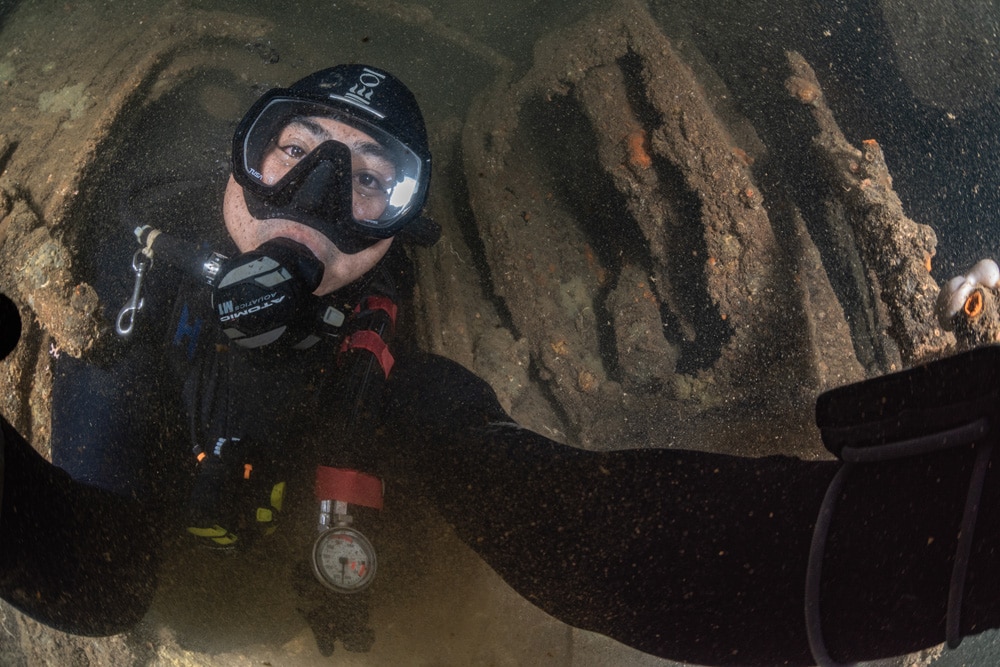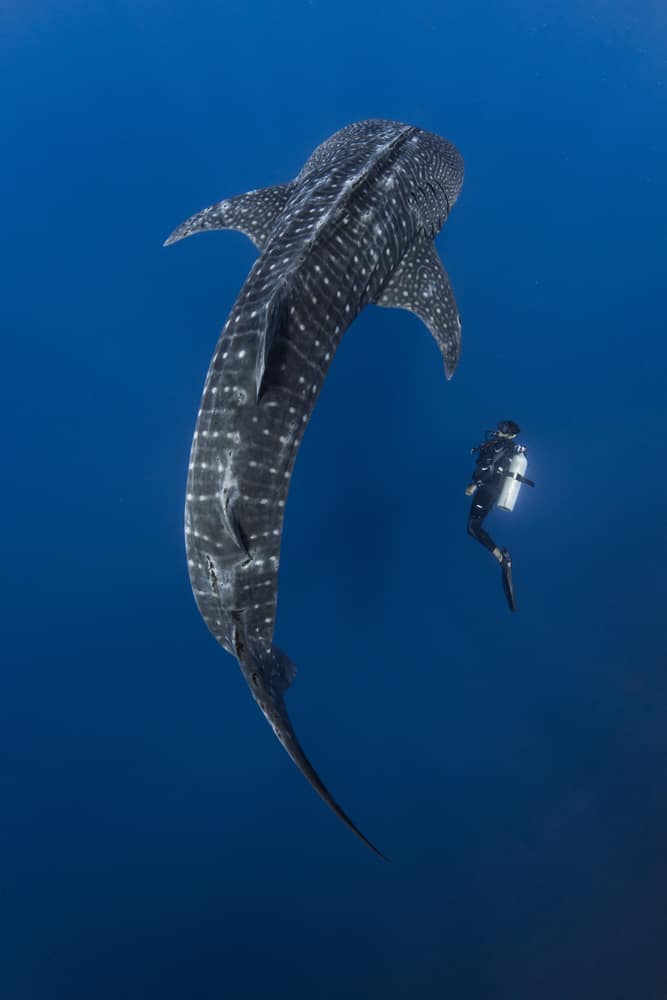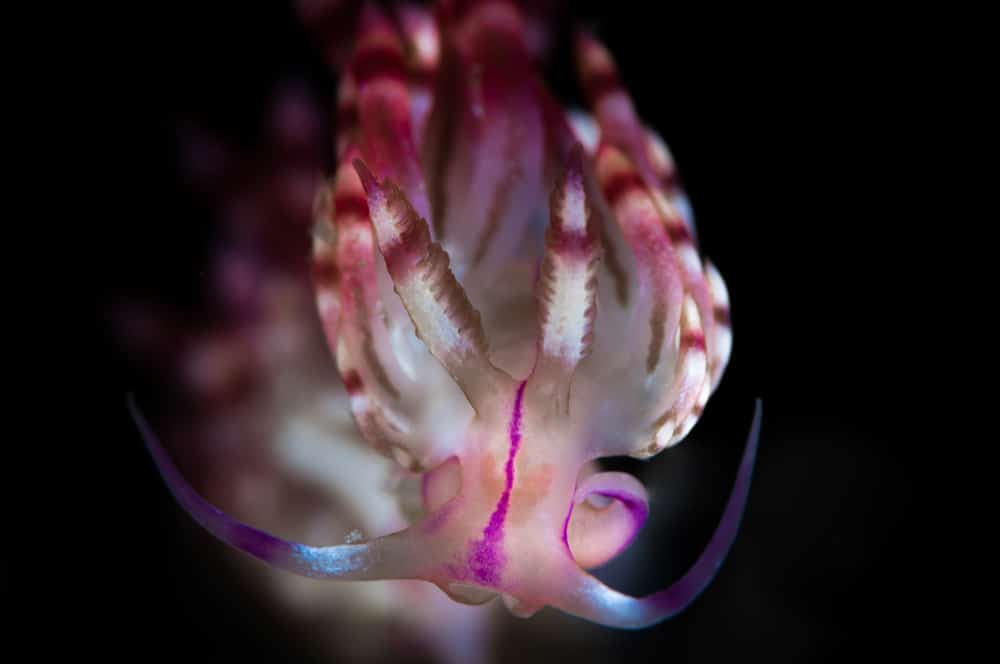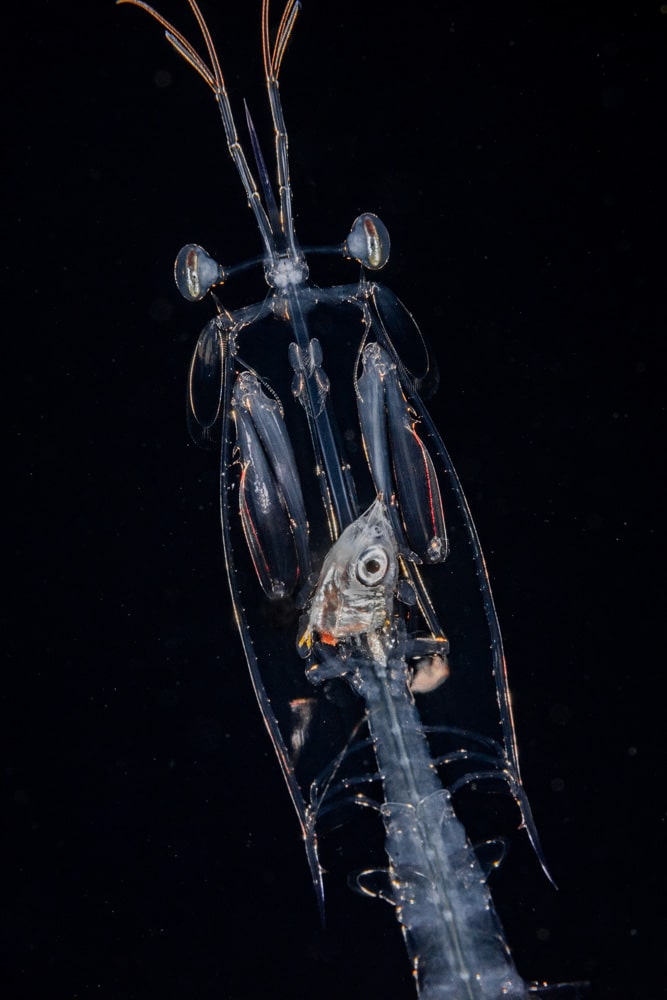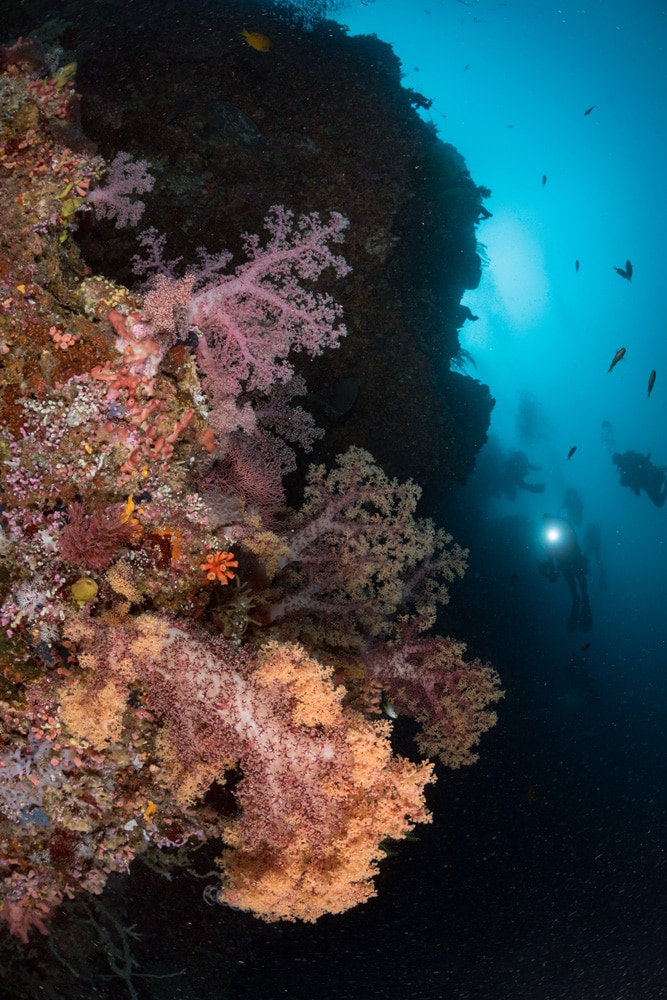Photo / Video News & Reviews
Scubaverse Underwater Photographer Interview: Ram Yoro

In this ongoing series, Scubaverse’s Underwater Photography Editor Nick Robertson-Brown talks to underwater photographers from around the world that he admires. In this blog: Ram Yoro
Ram lives in archipelagic Philippines where frequent excursions to nearby reefs in his early years triggered a life-long passion for exploring the oceans. His deep curiosity and love for the underwater world eventually made him leave a young corporate career to become a full-time scuba instructor and underwater photographer. For more than a decade since, Ram has actively conducted scuba lessons and underwater photography workshops in his base in Anilao.
As an underwater photographer, he is a pioneer and proponent of the Bonfire Diving method for documenting plankton in coastal waters. His appetite for exploration also led him into the realm of technical diving, and to specialize in underwater cave and wreck photography as member of the Filipino Cave Divers organization.
Aside from winning multiple awards over the years in the Anilao Shootout, a prestigious international live underwater photo competition, Ram also co-authored two books – the “Guide to Anilao” and “Legends Beneath the Waves: Philippines”. Moreover, he is also a major contributor to the following recent publications – “Black is the New Blue Volume II”, “Philippine Caves”, and “Philippine Coral Reefs”. When not in exploration mode, Ram spends his time with his little mermaids Yana and Mara, and wife Geraldine who is also a scuba diver.
NRB: How did your underwater photography start?
RY: I consider myself blessed to have witnessed and enjoyed the beauty of the reefs at a young age and always had this craving to share it with others. I thought the best way to do this is by taking photos underwater so I invested in a compact underwater setup as soon as I could afford one. Initially it was just to satisfy my impulse to share what I love to others, and later on it evolved into artistic pursuit. To this day, and many camera systems later on, the ocean still never fails to amaze me and I always find it full of awe-inspiring stories to tell. It is humbling to know that as an underwater photographer, I get to be an ambassador of the oceans – I get to sit in front of its daily spectacle and tell others about it.
NRB: What is your favourite u/w camera equipment (past & present) & why?
RY: I started underwater photography in the dawn of the digital age when camera system options were limited and less affordable. I initially had to make do with what I could just afford and went through a trial and error process with early Canon S- and G-series compact systems over the years. As anyone who has tried them would attest however, the main frustration with compact cameras is their slow auto-focus speed especially in low-light environments like underwater. In this department however, back then, I was pleasantly surprised at how the Canon G16 performed – it became my go-to camera for some time, enabling me to capture many fleeting and split-second macro moments which are not uncommon in the reefs. Nowadays, technology has improved and many compact camera options enviably have auto-focus speeds that satisfy the demands of the dim and ever-dynamic marine environment.
I had no plans, or no means rather, to upgrade to a DSLR system until my supportive wife surprised me with a Nikon D810 as a birthday present. The D810 was a beast – on top of a bigger sensor that delivers top image quality and superb low-light performance, it had excellent auto-focus performance and a deep dynamic range that allowed me to capture unique macro moments and emphasize depth in wide angle shots. With the various lens options available to DSLR systems also, I was encouraged to push my D810 into the exciting worlds of blackwater and bonfire diving, as well as underwater cave and wreck photography. Though it may not be top-of-line anymore today, I still treasure and hold dear my old and trusty Nikon D810 for the many adventures we’ve been through.
NRB: What would be your advice to anyone new to underwater photography?
RY: After all these years and having gone through several underwater camera systems, I realize I keep coming back to my underwater photography basics. I would thus share with them the same advice I would give my younger self in hindsight, as cliché as it may sound – build good fundamentals, then constantly practice and dare to evolve.
Your fundamentals – understanding of the exposure triangle and lighting principles, among other things – will enable you to work with any camera system or in any environment. It will make you less reliant on equipment but rather go with your knowledge and skills more, which is very liberating nowadays given how fast equipment upgrades come by.
Constant practice on the other hand is key to skill mastery. Practice makes perfect as they say, and skill-heavy underwater photography is no exception – no shortcuts here, but don’t worry this is the fun part! Mastery is only gained when muscle memory and instincts are developed through repetition over time.
And finally, dare to evolve – try new things and keep yourself up to date with the latest methods, styles and tricks. This will push your creativity and keep you engaged in underwater photography, and I believe is the secret to your longevity in the craft. Moreover, it will also expand and keep your portfolio always fresh and relevant to the times.
NRB: What, or who, has been your single biggest inspiration for your underwater photography?
RY: Like many in my generation of local underwater photographers in the Philippines, I have always had great admiration for the many works of Palme D’or awardee Scott “Gutsy” Tuason. It is ironic that while we Filipinos are blessed with countless of vibrant reefs, many of us take it for granted because most of us – in the past at least – have not seen nor enjoyed the fullness of its diverse beauty.
Gutsy was a pioneer in the Philippines in the sense that he was the first to visually document and share the many unseen treasures in our seas. The effect of his stunning images on me and many in my generation was profound, and it made me realize that photography can be a great tool for spreading awareness about our oceans and inspiring people to care for it. His works did not only encourage me to get into underwater photography, but also gave my craft a sense of purpose. Without Gutsy’s influence, I probably would not be as engaged in underwater photography as I am today, and the endeavour certainly would not have been as meaningful.
NRB: What image are you most proud of and why?
RY: It’s challenging to pick a photo given that the objectivity of a photographer is often clouded by the efforts invested in getting the shot. There is however a recent photo, taken in June 2019, that I couldn’t be more pleased with. It’s a photo of a wreck in the Brunei high seas, the Petani Mistral, which was later presented to Sultan Hassanal Bolkiah Himself! It’s a rare and great honor for any photographer’s work to be appreciated by His Majesty, and my gratitude to Poni Divers for making it possible. The image was to be part of a book project with Poni Divers about the amazing wrecks of Brunei – originally set to be released late 2020, but postponed to a future date when the ongoing pandemic eases.
NRB: Where is your favourite dive location, and is it for the photography?
RY: Because of its diversity, you can never have too much of Anilao and for that reason I decided to make it my diving base about a decade ago. For underwater photography, it is widely popular for macro but if you look beyond you will find that it actually has the complete package. It also has abundant wide angle opportunities, superb bonfire and blackwater diving, and even an underwater cave system as well as a small but entertaining wreck to enjoy. Logistically, its geographically sheltered location makes Anilao diveable all year round, and being only 3 hours away from Metro Manila makes it conveniently accessible. For non-photographers of any level, it is just as enjoyable with a variety of marine life covered reefs to choose from – walls, drop offs, slopes, submerged mounds, and small atolls perfect for long lazy dives. A favorite of many divers, including myself, once you’ve been to Anilao it’s hard to lose that itch to keep coming back.
NRB: What are you views on marine life manipulation, moving subjects?
RY: Marine life manipulation is a sad aspect of underwater photography and it has to stop. In many cases it is a reflection of skewed priorities, where the photograph comes above anything else. We forget that the underwater world is a unique place with its own dynamics, and our mindless intervention to setup the perfect shot may make a subject vulnerable to premature predation or cause it direct physical harm. This unchecked mind-set has become rampant, even systemic in some areas already, but it is never too late to change our ways.
Like many anthropogenic issues, stubborn ignorance is partly to blame and therefore education is the remedy. We need to take responsibility, create awareness and educate ourselves to effect a positive culture change. As an industry, we need to remind ourselves of the obvious, that the underwater world is a delicate living ecosystem and we – as capable beings and its beneficiaries – have the duty to care for it as stewards. We need to institutionally spread this mind-set through scuba courses, photo workshops, and dive briefings. And on a personal level, we can push for this in social media posts, in casual chit chats, and in our own little ways. This collective effort may take a while but will hopefully plant the seeds for a lasting and omnipresent culture of caring and stewardship for the oceans in our small but growing industry.
NRB: What do you look for when you are making your images?
RY: We always hope to encounter crazy behaviour, amazing portraits, or magnificent scenes, but in fact most of the time we are presented with the common and the ordinary. I have learned to temper expectations and make the most of what is given, and realized it is just as fulfilling to make the ordinary look extraordinary through photography. As every photo is a story, I try to find the hidden narrative or make one, and then proceed to make the framing, settings, and lighting artistically emphasize it.
NRB: What motivates you to take u/w photos?
RY: In as much as I enjoy the process of underwater photography itself, I find it very fulfilling to bring stunning images of the ocean closer to people. I think it is probably innate in all of us to want to share and preserve what is beautiful, and I’m very lucky to be able to use my underwater photography for the same purpose for the oceans. I am even more driven nowadays, as the oceans that we enjoy and depend on are threatened by a host of anthropogenic and other harmful factors. It is amazing how visual art can create awareness and inspire people to act.
NRB: If you could photograph any one thing/place what or where would that be?
RY: I have always been fascinated by the deep sea angler fish. A distant relative of the frogfish, they exist in very deep and dark waters, armed with sharp teeth and a bio-luminescent lure. Their appearance invokes a mixture of awe, fear, and science-fiction. It’s mind-boggling that such creatures even exist. But they do, and they remind us that there is so much life yet to been seen in the oceans and, as we’ve been told, we have only scratched the surface to date.
It is unlikely that an adult deep sea angler fish may be seen within the diving depths but larval and juvenile versions have been reportedly caught in plankton nets in the shallow depth ranges. I think an encounter with a young deep sea angler fish vertically migrating to the shallows at night to feed on plankton is just a matter of time. I am hoping I’d be at the right time and place during a bonfire or blackwater dive in plankton rich Balayan Bay in Anilao one of these days.
To see more of Ram’s work visit his Instagram page.
To read Ram’s features in Philippines Dive Adventures click here.
Blogs
Jeff Goodman Launches Underwater Moviemaker Course with NovoScuba

Transform Your Dive Experiences into Cinematic Masterpieces
NovoScuba has partnered with acclaimed underwater filmmaker Jeff Goodman to introduce the Underwater Moviemaker Course—a revolutionary program designed to equip divers with the skills to capture the breathtaking beauty of the underwater world.
Whether you’re an aspiring filmmaker, an avid diver, or a photography enthusiast, this course offers the tools and expertise needed to create stunning underwater videos. From vibrant coral reefs to curious marine life, you’ll learn how to film, edit, and produce captivating underwater stories, all with expert guidance from a seasoned professional.
Jeff Goodman: A Legacy in Underwater Filmmaking
Jeff Goodman brings over 40 years of experience in underwater film production for television to this course. Reflecting on his career, Jeff said:
“Although technology has dramatically changed, the basics of underwater filming remain constant. This course covers crucial skills for producing great videos. Whether you’re creating professional broadcast films or high-quality hobby videos, the fundamental principles are the same.
A camera operator must master their equipment to capture those magical underwater moments effortlessly. But beyond technical know-how, underwater filmmaking is about having fun and enhancing your diving experiences. So, take your time, learn at your own pace, and enjoy this creative journey.”
About NovoScuba
Founded in 2023, NovoScuba is reshaping dive education with a comprehensive, digitally native platform. Offering cutting-edge training programs for divers at all levels, NovoScuba sets a new benchmark in the diving industry by combining innovation with accessibility.
With ISO-certified courses, a student subscription model, and multilingual support, NovoScuba ensures that dive education is inclusive and engaging. More than just a training provider, NovoScuba fosters a global community of divers committed to exploration, collaboration, and sustainability.
Join the NovoScuba Underwater Moviemaker Course Today!
Dive into the world of underwater filmmaking and start creating cinematic stories that inspire. Learn more about the course and enroll today at www.novoscuba.com/novoscuba-underwater-moviemaker-course.
EXCLUSIVE: Jeff Goodman interviews Mark Spiers, CEO of New Scuba Diving Training Agency NovoScuba
NovoScuba’s Game-Changing Approach for Dive Store Owners: WE PAY YOU!
The diving world thrives on passion and adventure, but for many dive store owners, the financial and operational challenges can be as deep as the ocean.
NovoScuba, an emerging force in the diving world, is on a mission to transform this landscape for the better. With a revolutionary approach to dive store and training agency partnerships, NovoScuba is setting new standards for how dive stores can thrive while keeping their focus on delivering exceptional diving experiences.

A New Paradigm: NovoScuba’s Bold Mission
NovoScuba’s mission is straightforward yet profound: to disrupt the traditional dynamics between dive store owners and training agencies. Traditionally, dive stores have been subjected to substantial fees charged by training agencies, for membership, materials and certifications. These costs have often placed a heavy financial burden on store owners, cutting into their profits and limiting their ability to offer competitive prices to customers.
NovoScuba flips the script by offering a model where dive stores earn money, instead of paying high fees. Dive stores receive commissions for every student they register, and their certification costs are covered. This new model not only boosts profitability but also ensures clients get top-quality training at unbeatable prices.
Financial Upsides: Earn From Student Registration
NovoScuba’s approach is simple yet revolutionary. Dive stores partnering with NovoScuba can earn commissions for every student they enroll.
Here’s how it works: For every student enrolled through NovoScuba, dive stores receive a commission. Each student enrolled will receive their e-learning materials and certification credit included in their subscription. This arrangement is a significant departure from the traditional model, where dive stores often struggle to manage high overhead costs related to training fees and certification expenses.

NovoScuba’s approach ensures that dive stores can focus on what they do best—providing top-notch diving experiences—without being bogged down by excessive financial burdens, and the need to carry large stocks of materials.
Quality Training at a Great Price
NovoScuba stands out by offering high-quality, ISO certified, training that doesn’t break the bank, in fact our students will pay less than with most competing agencies. Clients benefit from top-notch education and safety standards at competitive prices. Dive store owners can confidently promote NovoScuba’s programs, knowing they’re offering fantastic training at affordable rates. This balance of quality and affordability helps dive stores build a strong reputation and attract more customers.
Your Brand is Your Business: NovoScuba’s Commitment to Showcasing Your Identity
At NovoScuba, we understand that your brand is your most valuable asset, and we’re committed to putting it front and centre. Unlike agencies that charge high fees to promote their own brand, we believe in investing in yours. With NovoScuba, you won’t be paying to advertise someone else’s logo alone, — our focus is on showcasing your unique identity. Certifications prominently feature your brand, as well as the training agency, reinforcing your store’s image and brand every step of the way. We’re here to support and elevate your brand, ensuring that your investment directly benefits your business.
Affordable Membership: An Investment in Your Success
NovoScuba’s membership model is designed with dive store owners in mind. Membership fees are kept low and include annual Pro member fees for your team. Payment can be made monthly or annually in your local currency, avoiding the hassle of exchange rate fluctuations. NovoScuba promises no exchange rate changes without a six-month notice, ensuring financial stability and simplifying budgeting. With a membership lasting 12 months from date of joining, you’ll enjoy a full year of NovoScuba’s benefits and support.

Streamlined Operations: Simplifying Your Workload
Handling administrative tasks can be a challenge, but NovoScuba makes it easier. We’ve streamlined certification procedures and reduced paperwork to help dive stores operate more efficiently. Certification processing is quick and straightforward, allowing more focus on teaching and customer service. Our system minimises bureaucracy by storing necessary forms in student profiles, reducing paperwork and administrative delays.
Crossover Made Easy
For dive stores looking to transition to NovoScuba’s model, the crossover process is designed to be smooth and hassle-free. NovoScuba provides support to ensure that the transition is as seamless as possible, helping dive store owners integrate into the new system with minimal disruption. Experienced dive Pros don’t need to undergo extensive retraining. Our crossover is designed to familiarise Pros with NovoScuba’s user-friendly platform, standards and course structures, and not to waste time and expense re-training in water.
With just a few simple steps, you’ll be ready to offer top-notch training through NovoScuba.
Comprehensive Business Support and Training Included in Your Membership
NovoScuba goes beyond financial benefits by offering experienced support and training. This value added service includes:
- Business Training: Optimise your operations with guidance on marketing, customer service, and best practices.
- Marketing and Promotion: Access resources to attract new customers and boost your store’s visibility. Enjoy cross promotions with NovoScuba to gain increased exposure.
- Ongoing Support: NovoScuba’s commitment to its partners extends beyond initial training and setup. The company offers ongoing support to address any issues or questions that arise. This continuous support ensures that dive store owners have a reliable resource to turn to whenever they need assistance.

Embracing Digital Natives: Instant Evolution and Continuous Improvement
NovoScuba’s digital-native approach is a game-changer. Leveraging cutting-edge technology, we ensure our services evolve and improve swiftly. Dive stores benefit from instant updates, the latest features, enhancements, and effective solutions, keeping them ahead of the curve. This continuous improvement helps dive stores stay competitive and deliver exceptional services. Whether it’s a new course update, additional marketing resources, or improved e-learning functions, NovoScuba’s digital infrastructure ensures that dive stores are always equipped with the most current and effective solutions. This continuous evolution not only helps dive stores stay ahead in a competitive market but also ensures they consistently provide top-quality services to their clients.
Why Is NovoScuba Doing This? – Fair Profit Sharing for Greater Access and Growth
At NovoScuba, we’ve taken a bold step by paying commissions to stores rather than following the traditional model of training agencies charging high fees. Our mission is to make diving accessible to everyone and to foster a growing community of new divers and continued education. By redistributing profits more equitably between stores and training agencies, we aim to create a more supportive and collaborative environment within the industry. We believe this approach not only helps individual stores thrive but also stimulates overall growth and innovation in diving. Our commitment to fair profit sharing reflects our dedication to the long-term health and expansion of the diving community.

Everyone is getting a piece of the pie.
Getting Started: Join the NovoScuba Revolution
Ready to revolutionise your dive store experience? NovoScuba is here to support your journey toward reduced costs, increased profitability, and enhanced operational efficiency. Get in touch with our team to learn how NovoScuba can transform your business.
For more information, email info@novoscuba.com or visit www.novoscuba.academy.
Blogs
The Benefits of Underwater Photography Workshops

Are you just getting started out in underwater photography or are you a seasoned shooter who wants to take their images to the next level? Whatever you experience or ability, here’s an overview of underwater photography workshops.
What is an Underwater Photography Workshop?
The first thing to note is that this is not ‘school’! There are no compulsory classes and at workshops you are free to pick and choose what you take part in, or otherwise.
A huge part of learning and developing your skills is through experimentation, trial and error, responding to feedback, and honing your technique. Underwater photography workshops provide you with the perfect platform for practice and improvement.
There is no better alternative to hands on experience in an environment that is 100% dedicated to your development. Reading informative articles and watching videos on YouTube can never replace the value of one on one time with your camera rig, underwater!
Underwater photography workshops are generally structured around core components, namely: presentations, underwater practice, feedback and critique sessions, troubleshooting/one-on-one sessions, and technical support.
Other components of a workshop include dining, relaxing, and time for socializing too!

What Topics do Underwater Photography Workshops Cover?
Depending on the pro, the type of workshop and regional diving highlights, a wide range of topics may be covered from composition and lighting through to shooting techniques and editing.
Benefits of an Underwater Photography Workshop
- Improve Your underwater photography
- Learn from professionals
- Learn from other participants
- Expand your photography knowledge and understanding
- Try put new techniques
- Learn how to maximize your camera rig
- Phenomenal travel opportunities
- Memorable experience and new friendships

Underwater Photography Workshops in the Lembeh Strait, Indonesia
When it comes to underwater photography workshops that focus on shooting macro, muck diving, and unusual marine species, there can be no better destination on the planet than the Lembeh Strait.
The Critter Capital of the World, a Muck Diving Mecca, and the Twilight Zone are just a few of the names that have been given to this stretch of water over the years due to its high density, and diversity, of rare and unusual marine life.
Some of Lembeh’s most iconic species include the hairy frogfish, Pontohi pygmy seahorse, the Lembeh sea dragon, Mandarin fish, Bobbit worms, Rhinopias scorpionfish, flamboyant cuttlefish, tiger and harlequin shrimps, ornate ghost pipefish, harlequin crabs, and where do we start with octopus? Here’s just a few… wunderpus, mimic, blue ring, hairy, long arm, starry night, and coconut… and the list goes on!
Dive conditions in the Lembeh Strait can be extremely favourable for underwater photographers. There is little to no current making both moving around and remaining stationary a breeze. The comfortably warm water temperatures reduce the cold that can also set in when not on the move.
Lembeh Resort and Underwater Photography Workshops
Lembeh Resort not only offers luxury accommodation in the Lembeh Strait but it is also offers a complete suite of facilities for underwater photographers and enthusiasts. Here is a ‘snapshot’ of the camera and imaging services that are on offer at Lembeh Resort – inside and outside of underwater photography workshops:
Photography Facilities
Lembeh Resort offers a suite of facilities for underwater photographers, including:
- The only Backscatter Authorized Photo Center in Asia
- Photo Center offering camera, housing, lights and accessory rentals and purchases, onsite repairs, onsite 3D printing of small components, professional support and assistance, full workshop support
- Full time onsite Photo Pro
- Full time onsite Marine Biologists
- Marine biology and underwater photography trained Dive Guides
- Spacious camera room with individual work spaces, lights, and power points
- Varied diving options including single dives in the Lembeh Strait, two or three tank dive trips, day trips to Bangka, east coast Lembeh trips, blackwater, bonfire, night, and Mandarin fish dives.

Capturing Critters in Lembeh Underwater Photography Workshop 2025
The renowned Capturing Critters in Lembeh Underwater Photography Workshop is back in January 2025 for the 12th year running!! This unique workshop is hosted by not one but three worldclass photo professionals. The 2025 workshop features: Ron Watkins (USA), Paul Duxfield (UK), and Renee Capozzola (USA). The week-long workshop promises to be packed with incredible diving, Pro presentations, and one-on-one instruction and feedback.
2025 Workshop Schedule and Dates:
- Pre-Workshop: January 8th ––10th (time to relax and unwind after traveling and enjoy some of Lembeh’s famous dive sites.)
- Workshop: January 11th – 17th (Capturing Critters in Lembeh 12th Annual Workshop)
- Workshop Extension: January 18th – 19th (Additional Day Workshop Extension)
- Post-Workshop: January 20th – 21st (Stay additional nights and enjoy extra diving days or some time to relax and explore more of North Sulawesi)
Find Out More:
Meet the pros and find out more about the Capturing Critters in Lembeh 2025 underwater photography workshop, including prices and workshop inclusions, here:
If you are ready to book your place on the January 2025 Capturing Critters in Lembeh Underwater Photography Workshop – contact Lembeh Resort at: reservations@LembehResort.com.
-

 News2 months ago
News2 months agoIconic SS United States to become the World’s Largest Artificial Reef
-

 News3 months ago
News3 months agoBook Review – 52 Assignments: Underwater Photography
-

 Gear News3 months ago
Gear News3 months agoDYNAMICNORD – New German diving brand enters the British market
-

 News3 months ago
News3 months agoExploring Cenote El Pit: A Diver’s Dream
-

 Gear News3 months ago
Gear News3 months agoTry BARE drysuits (and maybe even win one!) this Friday with Sea & Sea at North West Dive Fest
-

 Marine Life & Conservation3 months ago
Marine Life & Conservation3 months agoBook Review: Coral Triangle Cameos
-

 Blogs2 months ago
Blogs2 months agoDive the Egyptian Red Sea this Autumn with Regaldive
-

 News3 months ago
News3 months ago2024 Ocean Art Underwater Photo Competition Announced


